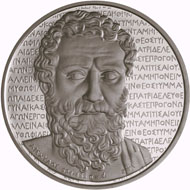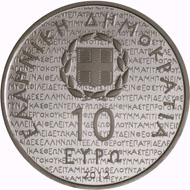January 3, 2012 – The Bank of Greece has issued a new collector’s coin which highlights an author of enduring reputation and innovation in a genre most prevalent in ancient Hellenic culture – that of the theatre in the form of tragedy. Aeschylus (c. 524-c. 456 BC) is largely credited with giving Greek tragedy its standard form and with elevating it to great artistic heights. He is regarded as the ‘father of Tragedy’ whose works which he is credited with are still read and performed to this day.
Source: Bronze bust of Aeschylus. Sailko / Wikipedia. http://creativecommons.org/licenses/by-sa/3.0/deed.de.
Born in Eleusis, a small town northwest of Athens, or western Attica, Aeschylus along with his brother Cynegeirus fought to defend Athens against invading the Persian army at the Battle of Marathon. He fought with such distinction during that decisive battle that his own epitaph commemorated his participation in the Greek victory at Marathon rather than his success as a playwright.
Aeschylus is most noted for expanding the number of characters in plays to allow for conflict and dialogue amongst them, whereas previously characters had interacted only with the chorus or, those players during the performance who commented with a collective voice on the dramatic action. One of his most influential works was written during the Persian invasion of Greece, (The Persians) which was the only classical tragedy written with current events in mind – and an event which took place during his lifetime. The play is also considered a useful source of information about that period.
This impressive coin is designed by George Stamatopoulos who is the artist behind the current one and two Greek Euro circulation coins as well as the 2009 10th anniversary EMU union coin produced by all member-states within the Euro-zone.
He has included a detailed front-facing portrait of the ancient author positioned towards the left half of the coin with a background of Greek words and dialogue from his many works. His name and year of birth and death as well as the Greek Mint’s mintmark are seen just to the base of the portrait.
The reverse design includes the Greek crest which is positioned towards the upper half with the coin’s denomination of ‘10 EURO’ in Greek just underneath with the year of issue ‘2012’ below the coin’s face value. The text ‘ELLENIKI DIMOKRATIA’ is seen along the upper edge. Struck to proof quality in sterling silver, the coin weighs 34.1 grams with a diameter of 40 mm. This coin’s mintage is authorised at just 5000 examples.
For more information on this and other coins offered by the Bank of Greece, please visit their website.
A special e-mail address has been arranged for interested collectors, to e-mail directly for information on ordering outside of Greece. To do so, please click here.
You can read in Aeschylus’ Oresteian trilogy, his masterpiece, here.







